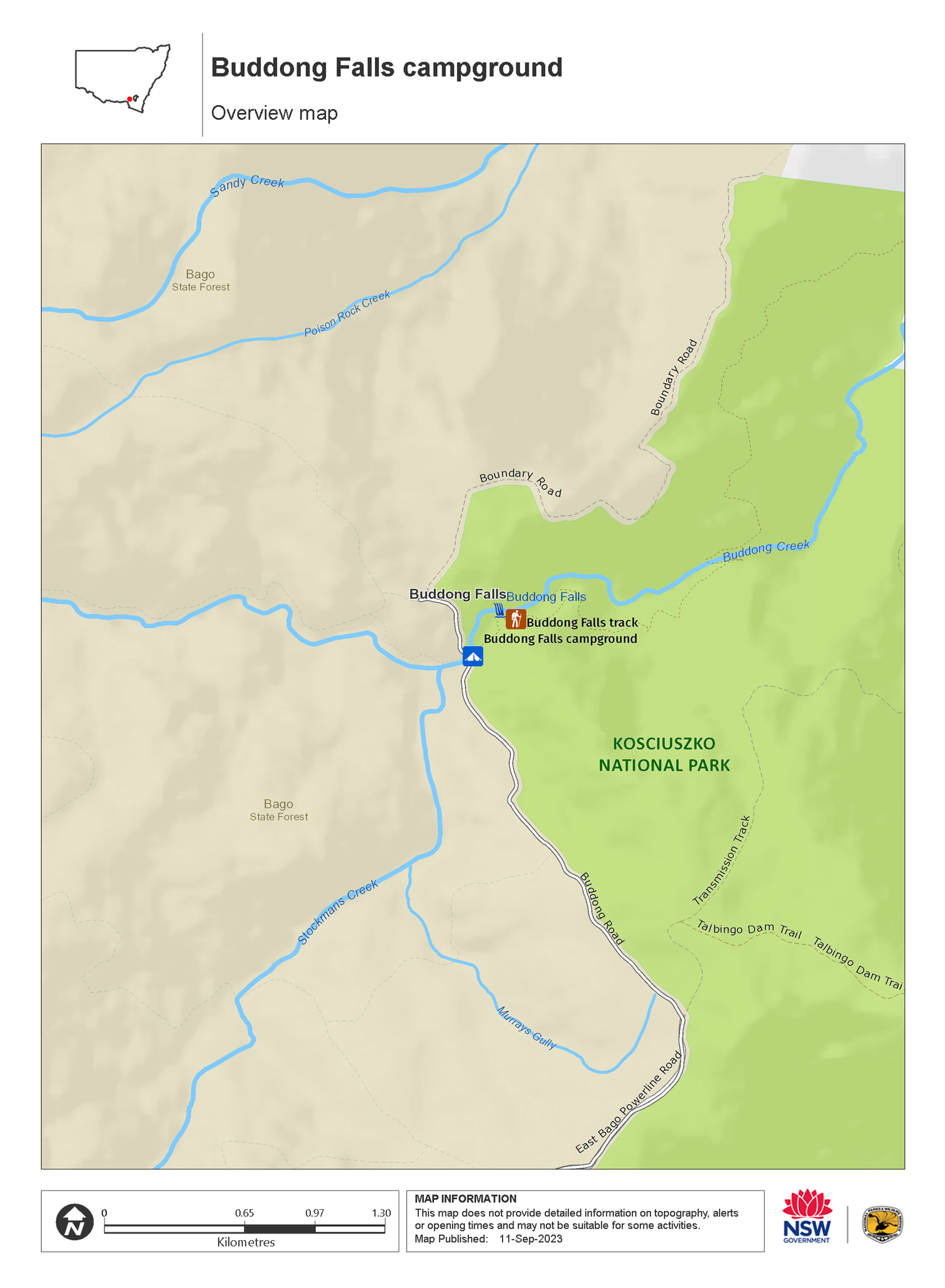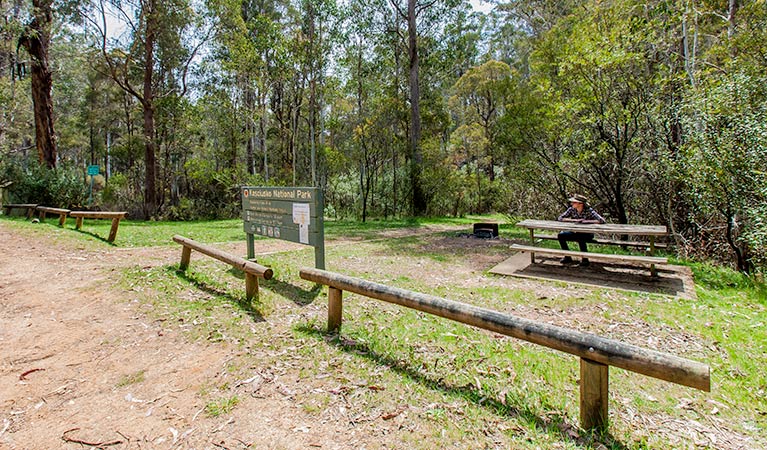Buddong Falls campground
Tumut area in Kosciuszko National Park
Overview
Remote and rustic Buddong Falls campground offers a tranquil spot with walking and waterfalls in Kosciuszko National Park, near Talbingo township.
| Number of campsites | 1 |
|---|---|
| Camping type | Tent, Don't mind a short walk to tent |
| Facilities | Picnic tables, barbecue facilities, carpark, toilets |
| What to bring | Drinking water, firewood |
| Price | There are no camping fees at this campground but a $6 booking fee applies. |
| Group bookings | School groups and Park Eco Pass holders can make a group booking enquiry. |
| Trip Intention Form |
Are you planning a bushwalk, going somewhere remote or where the weather is extreme? It's a good idea to let someone know where you're going. Fill in a trip intention form to send important details about your trip to your emergency contact. |
| Personal Locator Beacon |
Hire a Personal Locator Beacon (PLB) for free at Snowy Region Visitor Centre in Jindabyne, Perisher Valley Office, Tumut Visitor Centre or Khancoban Visitor Centre. |
| Please note |
|
For a weekend getaway far from the crowds, pack up the 4WD and head for Buddong Falls campground, in the remote north-west region of Kosciuszko National Park, near Talbingo township. This rustic creekside camping spot is close to picturesque waterfalls and walking tracks, ideal for independent campers seeking a tranquil haven.
Set amongst tall forests of smooth-barked ribbon gums, pitch your tent before exploring the nearby creek and waterfall. If you’re ready to stretch your legs, Buddong Falls walking track leads to two pretty waterfalls and forms part of the longer Hume and Hovell walking track.
During the day, parrots and tree-creepers may be seen flitting amongst the branches. At night, settled in around a campfire, you might glimpse possums and gliders.
Map

Map legend

Local alerts
For the latest updates on fires, closures and other alerts in this area, see https://www.nationalparks.nsw.gov.au/camping-and-accommodation/campgrounds/buddong-falls-campground/local-alerts
Bookings
- National Parks Contact Centre
- 7am to 7pm daily
- 1300 072 757 (13000 PARKS) for the cost of a local call within Australia excluding mobiles
- parks.info@environment.nsw.gov.au
Operated by
- Tumut Region Visitor Centre
- 9am to 5pm daily. Closed Christmas Day.
- 02 6947 7025
- tumutrvc@environment.nsw.gov.au
- The Old Butter Factory, 5 Adelong Road, Tumut NSW 2720
Park info
- in the Tumut area of Kosciuszko National Park in the Snowy Mountains region
The Tumut area is open all year but some roads and trails may close due to weather conditions or park management issues.
-
No park entry fees apply in the Tumut area. See vehicle entry fees for other areas in Kosciuszko National Park.
Buy annual pass.
Visitor info
All the practical information you need to know about Buddong Falls campground.
Maps and downloads
Visitor centre
-
Tumut Visitor Centre
The Old Butter Factory, 5 Adelong Road, Tumut NSW 2720 - 9am to 5pm daily. Closed Christmas Day.
- 02 6947 7025
Learn more
Buddong Falls campground is in Tumut area. Here are just some of the reasons why this park is special:
Explore by water, wheels or walking

If you need some inspiration, stop by the Tumut Visitor Centre, for tips on top experiences, where to stay, and spot a corroboree frog in the display. Learn more about Kosciuszko National Park’s plants, animals and landscapes on an Aboriginal ranger-led tour (contact the visitor centre). Boat ramps on Blowering Reservoir, Talbingo Dam wall, and at O’Hares campground provide easy access for boating and paddling. There are also plenty of scenic drives, walking tracks and bike trails to tempt you away from the water. If you’re well-prepared, explore the remote Goobarragandra Wilderness or hike part of the 425km Hume and Hovell walking track.
- Black Perry lookout Black Perry lookout, near Talbingo Mountain in Kosciuszko National Park, offers scenic views over the Snowy Mountains region, and is close to Tumut and Yarrangobilly Caves.
- Tumut Visitor Centre Tumut Visitor Centre, on Snowy Mountains Highway, is the ideal starting point for a visit to northern Kosciuszko National Park, offering information, booking services, and souvenirs.
World-class wilderness

In recognition of Kosciuszko's unique value as a conservation area, it’s been named a UNESCO Biosphere Reserve. More than half of the park, over 350,000ha, has been declared wilderness, including the Bogong Peaks and Goobarragandra wilderness areas. Black Perry lookout is an excellent place to get a sense of the expansive wilderness areas in Kosciuszko's north.
Snowy Mountains history

Tumut area’s more recent history can be seen at Blowering Reservoir, and just outside the park at Talbingo. The Snowy Hydro Scheme is recognised as one of the civil engineering wonders of the modern world. Its vast network of dams and power stations includes Blowering, Jounama and Talbingo reservoirs, and Tumut 3 Power Station, at Talbingo.
Unique landscapes

The change in scenery is noticeable as you drive along Snowy Mountains Highway. The road climbs over 1000m from the Tumut River Valley, through woodland of mountain gum and narrow-leaf peppermint, to the treeless plains surrounding Kiandra.
- Black Perry lookout Black Perry lookout, near Talbingo Mountain in Kosciuszko National Park, offers scenic views over the Snowy Mountains region, and is close to Tumut and Yarrangobilly Caves.
- Landers Falls lookout walk Landers Falls lookout walk, tucked into the forest between Tumut and Kiandra, wows you with dramatic views of Landers Creek waterfall plunging into the rocky gorge above Talbingo Reservoir.
Plants and animals protected in this park
Animals
-

Swamp wallaby (Wallabia bicolor)
The swamp wallaby, also known as the black wallaby or black pademelon, lives in the dense understorey of rainforests, woodlands and dry sclerophyll forest along eastern Australia. This unique Australian macropod has a dark black-grey coat with a distinctive light-coloured cheek stripe.
-

Yellow-tailed black cockatoo (Calyptorhynchus funereus)
The yellow-tailed black cockatoo is one of the largest species of parrot. With dusty-black plumage, they have a yellow tail and cheek patch. They’re easily spotted while bird watching, as they feed on seeds in native forests and pine plantations.
-

Common brushtail possum (Trichosurus vulpecula)
One of the most widespread of Australian tree-dwelling marsupials, the common brushtail possum is found across most of NSW in woodlands, rainforests and urban areas. With strong claws, a prehensile tail and opposable digits, these native Australian animals are well-adapted for life amongst the trees.
-

Common ringtail possum (Pseudocheirus peregrinus)
Commonly found in forests, woodlands and leafy gardens across eastern NSW, the Australian ringtail possum is a tree-dwelling marsupial. With a powerful tail perfectly adapted to grasp objects, it forages in trees for eucalypt leaves, flowers and fruit.
-

Bare-nosed wombat (Vombatus ursinus)
A large, squat marsupial, the Australian bare-nosed wombat is a burrowing mammal found in coastal forests and mountain ranges across NSW and Victoria. The only other remaining species of wombat in NSW, the endangered southern hairy-nosed wombat, was considered extinct until relatively recently.
-

Emu (Dromaius novaehollandiae)
The largest of Australian birds, the emu stands up to 2m high and is the second largest bird in the world, after the ostrich. Emus live in pairs or family groups. The male emu incubates and rears the young, which will stay with the adult emus for up to 2 years.
-

Platypus (Ornithorhynchus anatinus)
One of the most fascinating and unusual Australian animals, the duck-billed platypus, along with the echidna, are the only known monotremes, or egg-laying mammals, in existence. The platypus is generally found in permanent river systems and lakes in southern and eastern NSW and east and west of the Great Dividing Range.
-

Short-beaked echidna (Tachyglossus aculeatus)
One of only 2 egg-laying mammals in the world, the short-beaked echidna is one of the most widespread of Australian native animals. Covered in spines, or quills, they’re equipped with a keen sense of smell and a tube-like snout which they use to break apart termite mounds in search of ants.
-

Superb lyrebird (Menura novaehollandiae)
With a complex mimicking call and an elaborate courtship dance to match, the superb lyrebird is one of the most spectacular Australian animals. A bird watching must-see, the superb lyrebird can be found in rainforests and wet woodlands across eastern NSW and Victoria.
-

Wedge-tailed eagle (Aquila audax)
With a wingspan of up to 2.5m, the wedge-tailed eagle is Australia’s largest bird of prey. These Australian animals are found in woodlands across NSW, and have the ability to soar to heights of over 2km. If you’re bird watching, look out for the distinctive diamond-shaped tail of the eagle.

